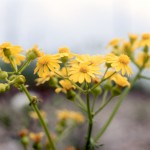Butterweed
Senecio glabellus
Asteraceae (Sunflower Family)
Description
Butterweed is a cool-season annual that usually grows to 18 to 20 inches tall. On rare occasions it grows to 40 inches. The basal leaves, up to 4 inches long, are deeply lobed, with oblong, lateral lobes having wavy margins.
Although the plant usually has one stalk, it occasionally has a few. It can be unbranched or branched above, depending upon moisture and soil fertility.
Numerous yellow flowers stand on short stalks, forming a large terminal cluster.
Habitat
Butterweed may be found in many of the areas of Texas, but large populations are usually present only in the eastern third of the state. It is often found in clay or heavy loam soils in disturbed areas, stream bottoms, ditches and flood plains.
Toxic Agent
These plants contain pyrrolizidine alkaloids that cause progressive liver cirrhosis. Consumption of large amounts of the plant can result in acute liver necrosis. However, in most instances, several months elapse between consumption and the appearance of clinical signs. Horses, cattle and llamas have died of liver cirrhosis after being on pastures containing butterweed.
Signs of Livestock Ingestion
Sudden death has been seen in some cases in which horses were placed on almost pure butterweed paddocks with no hay or feed.
Most animals are clinically normal for several months after consuming the plant and then demonstrate signs of poisoning, which are all related to loss of liver function and can include: Anorexia; Depression; Weight loss; Aggression; Death.
Management Strategies
Animals should not be forced to consume these unpalatable plants. Poisoning has not been observed in species other than llamas if there is adequate pasture or good quality hay and feed available. Llamas may be more sensitive to the pyrrolizidine alkaloids or less discriminating in their eating habits.
Sheep are more resistant to pyrrolizidine alkaloid poisoning and may be used to "clean" the pastures while the plants are young. Severe infestations may be controlled with broadleaf herbicides such as 2,4-D or Grazon P+D® at 0.5 to 1.0 pound a.i./acre in the spring with good growing conditions.
Images
Plant Characteristics
Flower Color: Yellow
Seed Type: Non-Encapsulated
Duration: Annual
Stem Texture: Hairless/Smooth
Growth Habit: Forbs/Broadleaf
Leaf Shape
 : Simple with Pinnate or Parallel Venation
: Simple with Pinnate or Parallel Venation
Season: Cool
Distribution
 : 01 - Pineywoods, 02 - Gulf Prairies and Marshes, 03 - Post Oak Savannah, 04 - Blackland Prairies, 05 - Cross Timbers and Prairies
: 01 - Pineywoods, 02 - Gulf Prairies and Marshes, 03 - Post Oak Savannah, 04 - Blackland Prairies, 05 - Cross Timbers and Prairies
Distributions
Distribution refers to the ecological region in Texas that a plant has been found. You can also view a clickable map.
Book: Toxic Plants of Texas (B-6105)
Collection: Toxics, Wild Flowers





